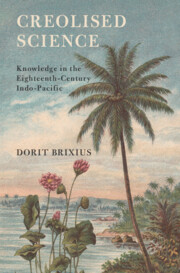Book contents
- Creolised Science
- Science in History
- Creolised Science
- Copyright page
- Dedication
- Contents
- Figures
- Acknowledgements
- Author’s Note
- Abbreviations
- Introduction
- 1 The Limits of French Colonial Visions and Science
- 2 The Acquisition of Knowledge and Plants, from Madagascar to China
- 3 Agriculture and Everyday Knowledge
- 4 Enslaved People as Knowledge Carriers
- 5 The Cross-Cultural Quest for Spices in South East Asia
- 6 Materials, Environment, and the Application of Knowledge
- Conclusion
- Bibliography
- Index
5 - The Cross-Cultural Quest for Spices in South East Asia
Published online by Cambridge University Press: 03 April 2024
- Creolised Science
- Science in History
- Creolised Science
- Copyright page
- Dedication
- Contents
- Figures
- Acknowledgements
- Author’s Note
- Abbreviations
- Introduction
- 1 The Limits of French Colonial Visions and Science
- 2 The Acquisition of Knowledge and Plants, from Madagascar to China
- 3 Agriculture and Everyday Knowledge
- 4 Enslaved People as Knowledge Carriers
- 5 The Cross-Cultural Quest for Spices in South East Asia
- 6 Materials, Environment, and the Application of Knowledge
- Conclusion
- Bibliography
- Index
Summary
This chapter has a sociocultural approach to the quest for nutmeg and cloves. It analyses human, cross-cultural encounters in South East Asia, the native countries of numerous spices introduced in Mauritius over the course of the eighteenth century. As this chapter reveals, the French colonial spice project involved actors from different backgrounds for patronage, protection, and assistance. They used a mix of languages, promises, and informal relations mainly in South East Asian islands (the Maluku islands and the Philippines). The purpose of this chapter is to understand the movements of knowledge and people within cross-cultural interactions in the Indo-Pacific through the lens of plant exchange. These cross-cultural connections were essential for this project: Asian merchants and brokers were indispensable for acquiring spice plants and grains from Dutch colonial territory in today’s Indonesia. Insisting on the cross-cultural nature of the acquisition of spice plants, this chapter challenges existing narratives of the cultural components of the French empire.
Keywords
- Type
- Chapter
- Information
- Creolised ScienceKnowledge in the Eighteenth-Century Indo-Pacific, pp. 156 - 182Publisher: Cambridge University PressPrint publication year: 2024

